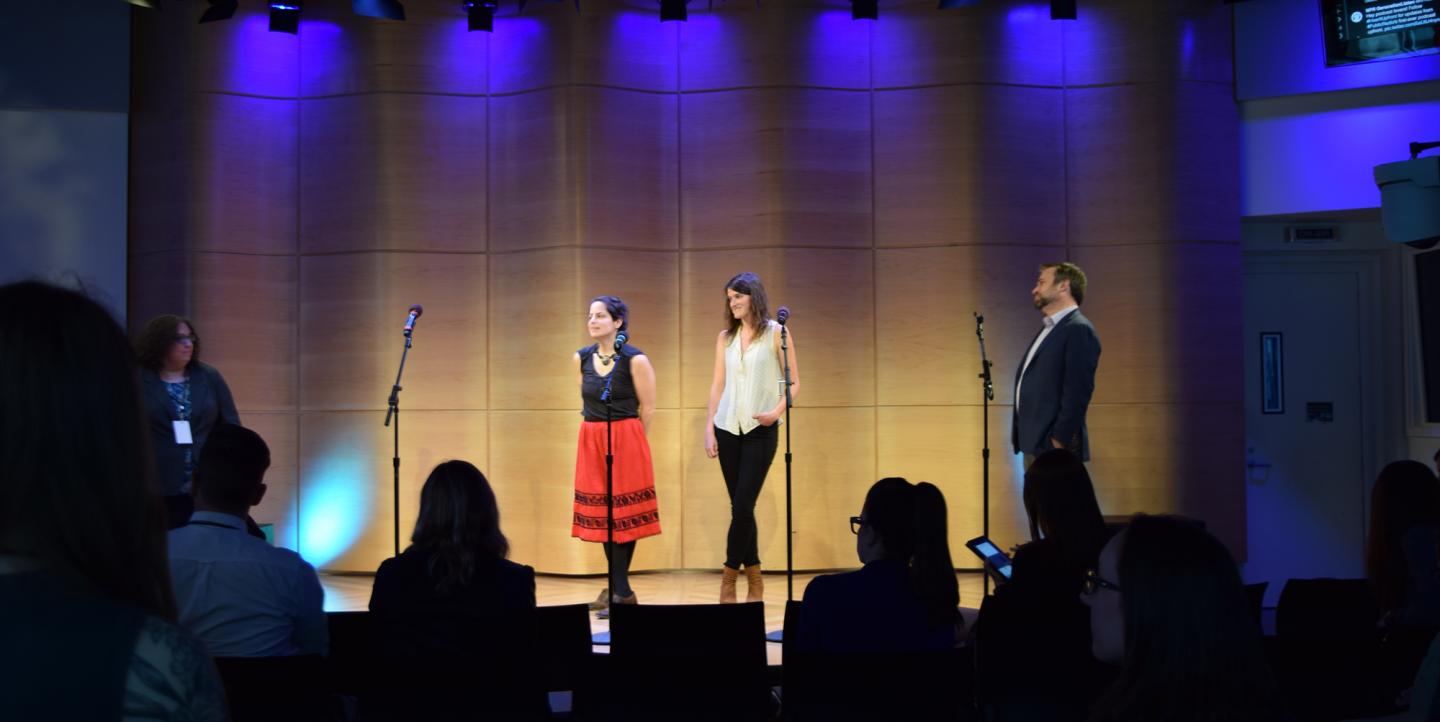The podcast explosion that occurred after Sarah Koenig began reporting on the 1999 murder of Hae Min Lee in Baltimore was partly due to the Serial team’s compelling storytelling and hard work.
But Serial — and the podcasting boom — also had some help from Apple.
Just before Serial’s release in October 2014, Apple released its much-anticipated iPhone 6, which came pre-installed with a podcast app. Koenig — a longtime producer at This American Life — worried people wouldn’t be able to figure out how to listen. But Serial went on to amass 7 million downloads per episode, This American Life host Ira Glass told the audience at NPR, WBEZ and WYNC’s first ever podcast upfront.
“Thirty years ago when I started making stories … you could fit all the people who listened into one minivan,” Glass said. “[Now] we are an army, and we are an army on the march.”
While 33 percent of Americans 12 years of age and older have listened to at least one podcast according to data published by Edison Research, the army of podcast hosts, producers and enthusiasts who attended NPR’s podcast upfront consisted of listeners who have valued podcasts for some time. Podcasts, after all, came out 10 years ago, although the hosts of those shows weren’t nearly as recognizable as Koenig. However, the spirit of a process that is “so democratic” is what makes the current podcast movement so great, WBEZ producer and Nerdette host Tricia Bobeda explained.
“Anyone with a microphone can start a podcast,” Bobeda said. “The gatekeepers are officially gone.”
“It feels like right now, in this moment of podcasting, [that] it’s like the early days of NPR,” she added. “There are no rules and everyone is trying to figure it out.”
After 10 years, two hit podcasts (aside from Serial, NPR’s Invisibilia also defied expectations with 5 million downloads per episode) and a whole lot of fanfare, what do we know about the nature of podcasts and the habits of listeners?
Below, IJNet shares some trends noticed by podcasters who spoke at WNYC before the podcast upfront event. They also shared some tips for readers who might want to venture into podcasting:
Listening to a piece of audio is an intimate experience. Unlike radio, people choose when and where to press play on their podcast app of choice. It can be consumed while doing virtually anything anywhere. From a work commute to the gym, a podcast is always nearby. Deciding when and where to listen is also crucial.
Anna Sale, the host of Death, Sex and Money, said she’s not afraid to drop a curse word here and there or discuss taboo topics on her show because “the listener comes to you when it’s an appropriate time.”Unlike a radio segment, podcasts don’t have set time limits, which makes production slightly easier. (Not necessarily for Invisibilia co-hosts Lulu Miller and Alix Spiegel, who said they’ve done plenty of three- and four-hour interviews.) But the luxury of time doesn’t mean producers and hosts should go on forever.
“Whatever time you have chosen, you have to promise something [in return],” Planet Money correspondent Robert Smith said, adding that you have a contract with your listener and you have to prove you’re worth their time.Since Invisibilia relies heavily on science to explain human behavior, Miller and Spiegel spend a lot of time talking to “really smart people and force them to make [concepts] clearer,” Miller explained.
Keeping time in mind, don’t be afraid to record “brain dumps” for snippets of the podcast, she added. Sometimes it’s good to discuss everything with your co-host and use it as an explainer, especially if you’re dealing with complicated subjects.The podcast world hasn’t exactly narrowed down too many characteristics about listeners. They do tend to be younger and use smartphones to listen. As podcasts become more popular and the need to diversify advertisers increases, NPR, WBEZ and WNYC are still searching for ways to capture their audiences in data sets.
Working with Edison Research, public radio discovered that among monthly podcast listeners, 62 percent have listened to at least one public radio podcast within the past month. In addition, public radio podcast listeners ages 25 to 34 took in an average of 6.8 podcasts a week.Globally, there is still uncertainty about podcasts' popularity, though multiple hosts said they know people listen by paying attention to social media engagement. WBUR-Boston On Point host Tom Ashbrook shared that he recently received an email from a listener in the West African country of Benin.
If you’re making your own podcast and posting it to SoundCloud, Stitcher or Downcast, make sure to tag keywords so people can find it. “Taxonomy on the Internet is hard, especially with an MP3,” Bobeda said.
Still interested? Check out NPR's Storify of the event by clicking here.
Main image of Alix Spiegel, Lulu Miller and Robert Smith by IJNet.

